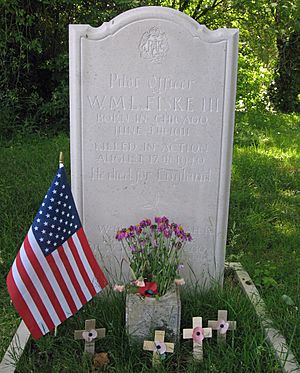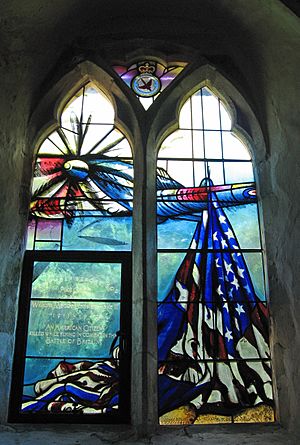Billy Fiske facts for kids
Quick facts for kids
Billy Fiske
|
||||||||||||||||||
|---|---|---|---|---|---|---|---|---|---|---|---|---|---|---|---|---|---|---|
 |
||||||||||||||||||
| Birth name | William Meade Lindsley Fiske III | |||||||||||||||||
| Nickname(s) | Billy | |||||||||||||||||
| Born | 4 June 1911 Chicago, Illinois, U.S. |
|||||||||||||||||
| Died | 17 August 1940 (aged 29) Chichester, England |
|||||||||||||||||
| Buried |
St Mary and St Blaise churchyard in Boxgrove, Sussex
|
|||||||||||||||||
| Allegiance | ||||||||||||||||||
| Service/ |
Royal Air Force Volunteer Reserve | |||||||||||||||||
| Years of service | 23 March 1940 – 17 August 1940 | |||||||||||||||||
| Rank | Acting Pilot Officer | |||||||||||||||||
| Unit | No. 601 Squadron RAF | |||||||||||||||||
| Battles/wars | World War II | |||||||||||||||||
| Relations | Jennison Heaton (brother-in-law) | |||||||||||||||||
|
||||||||||||||||||
William Meade Lindsley Fiske III (born June 4, 1911 – died August 17, 1940) was an amazing American athlete and brave fighter pilot. He was a champion bobsledder, winning two gold medals at the Winter Olympics. Later, he showed incredible courage by joining the British Royal Air Force during World War II, even though the United States was not yet in the war. He became the first American citizen pilot to die in action during World War II, fighting for freedom.
Between his Olympic career and military service, Billy Fiske helped create the first ski resort in Aspen, Colorado. He built the first ski lift and lodge there.
Contents
Early Life and Aspen Skiing
Billy Fiske was born in Chicago in 1911. His father, William Fiske, was a successful banker. Billy went to school in Chicago and then in France in 1924. In France, at age 16, he discovered the exciting sport of bobsled. In 1928, he studied Economics and History at Trinity Hall, Cambridge in England.
In 1936, Billy and his friend Ted Ryan saw photos of mountains near Aspen, Colorado. They realized these mountains would be perfect for downhill skiing. They wanted to build a ski resort like those in the Alps, where Billy had competed.
Billy and Ted visited Aspen, which was an old mining town. Many properties were cheap. Billy bought an option on one, and they planned a ski lodge. In late 1937, the lodge opened, and soon after, the "Boat Tow" ski lift began operating. This was the start of skiing in Aspen.
Billy later worked for a bank in London. He married Rose Bingham, the Countess of Warwick.
Olympic Bobsled Champion
In 1928, Billy Fiske became the youngest gold medalist in any winter sport at the 1928 Winter Olympics in St. Moritz, Switzerland. He was only 16 years old. He was the driver for the first five-man US Bobsled team to win an Olympic gold medal. His teammates were Geoffrey Mason, Nion Tocker, Clifford Gray, and Richard Parke.
Billy competed again at the 1932 Winter Olympics in Lake Placid, New York. He proudly carried the United States' flag at the opening ceremony. The race format changed to a four-man team, but Billy and his teammates—Clifford Gray, Eddie Eagan, and Jay O'Brien—won another gold medal.
Billy was asked to lead the bobsled team for the 1936 Winter Olympics in Germany, but he said no. Some believe this was because he disagreed with the political situation in Germany at the time. This might also explain why he decided to join the war effort later.
Billy was also a champion at the Cresta Run, a famous ice track. He was known for his daring jumps from the bar chandelier at the Badrutt's Palace Hotel in St. Moritz!
Hero in World War II
Just before World War II began, Billy returned to England. On August 30, 1939, he joined the Royal Air Force Volunteer Reserve. The United States was neutral at the time, so Billy pretended to be Canadian to be allowed to join. He was one of seven American airmen who fought in the Battle of Britain. He became a Pilot Officer on March 23, 1940.
Billy trained to fly at RAF Yatesbury and RAF Brize Norton. As an American citizen, he promised his loyalty to King George VI and was officially accepted into the RAF. He wrote in his diary that he believed he was the first U.S. citizen to join the RAF in England after the war started.
On July 12, 1940, Billy joined No. 601 Squadron RAF, a unit that flew Hawker Hurricane planes. This squadron was known as the "Millionaires' Squadron." Billy flew his first missions on July 20.
On August 16, 1940, during the intense Battle of Britain, Billy's squadron was sent to stop German dive-bombers. Billy was flying Hurricane P3358. His squadron destroyed eight German Stuka planes. But after only 15 minutes of flying, a German gunner shot a bullet through Billy's fuel tank.
His plane was badly damaged, and his hands and ankles were burned. Instead of bailing out (parachuting), Billy bravely flew his damaged Hurricane back to the airfield. He landed safely at RAF Tangmere, but he had to be pulled from the plane. Soon after, his fuel tank exploded. Billy was taken to the hospital in Chichester, but he died from his injuries the next day, on August 17. Billy Fiske was 29 years old.
Billy's funeral was held on August 20, 1940. Six members of the Tangmere ground staff carried his coffin. It was covered with the Union Jack (British flag) and the Stars and Stripes (American flag). He was buried at Boxgrove Priory Church.
Billy's Flight Commander, Sir Archibald Philip Hope, said:
Unquestionably Billy Fiske was the best pilot I've ever known. It was unbelievable how good he was. He picked up so fast it wasn't true. He'd flown a bit before, but he was a natural as a fighter pilot. He was also terribly nice and extraordinarily modest, and fitted into the squadron very well.
Memorials and Tributes
Billy Fiske is buried in St Mary and St Blaise churchyard in Boxgrove, Sussex. His gravestone simply says: He died for England. His funeral was shared widely to inspire others. A special stained glass window was placed in his honor at Boxgrove Priory on September 17, 2008. Billy is also listed on the Battle of Britain Monument in London and the Battle of Britain Memorial, Capel-le-Ferne.
On July 4, 1941, a plaque was put up in the crypt of St Paul's Cathedral in London. The plaque reads: An American citizen who died that England might live. This date was chosen because it was American Independence Day. The British Prime Minister, Winston Churchill, wanted to share Billy's story to encourage American support. Sir Archibald Sinclair, the Secretary of State for Air, unveiled the plaque. He said:
Here was a young man for whom life held much. Under no kind of compulsion he came to fight for Britain. He came and he fought and he died.
Other tributes to Billy include a memorial tablet in the crypt of the Cathedral of Saint John the Divine, New York. The United States Bobsled and Skeleton Federation also created the Billy Fiske Memorial Trophy. This trophy is given to the national champion four-man bobsled team every year.
A documentary called American Warrior: Billy Fiske was made in 2005. A play about his life, Billy Fiske: King of Speed, was performed in 2010.
The Billy Fiske Foundation is working to put up a statue of Billy Fiske in Nine Elms Park near the U.S. embassy in London.
See also



